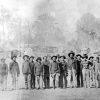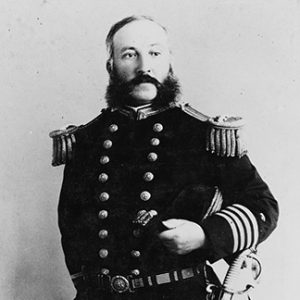calsfoundation@cals.org
Thomas O. Selfridge Jr. (1836–1924)
Thomas O. Selfridge Jr. was a career U.S. Navy officer who commanded vessels operating around Arkansas during the Civil War and was indirectly responsible for the later destruction of the town of Napoleon (Desha County).
Thomas Oliver Selfridge was born on February 6, 1836, in Charleston, Massachusetts, the son of Thomas O. Selfridge Sr.—who would become a rear admiral in the U.S. Navy—and Louisa Cary Soley Selfridge. He attended English High School in Boston, Massachusetts, prior to entering the U.S. Naval Academy at Annapolis, Maryland, in 1851. The academy was then beginning a model in which cadets would undergo a four-year term of instruction. Selfridge and five colleagues graduated early in 1854 because the navy had a shortage of junior officers; Selfridge was at the top of his class and laid claim to being the academy’s first graduate.
He served two years with the Pacific Squadron before becoming a passed midshipman in 1856 and was promoted to master two years later. Selfridge conducted a survey of U.S. coastal waters in 1857 before being assigned to the Africa Squadron. He was promoted to lieutenant in 1860 and joined the crew of the USS Cumberland. When the Civil War began, he led a group of men from the Cumberland who destroyed buildings and equipment at the Gosport Navy Yard in Norfolk, Virginia, to keep them out of Confederate hands.
Selfridge was on the Cumberland when the new iron-clad CSS Virginia—formerly the USS Merrimack—attacked and sank it at Hampton Roads, Virginia, on March 8, 1862. He briefly commanded the USS Monitor following that vessel’s historic battle with the Virginia.
In July 1862, Selfridge took command of the USS Alligator, an early attempt at creating a submarine; he eventually declared that “the enterprise is a failure.” Selfridge and the Alligator’s crew were then transferred to the iron-clad gunboat the USS Cairo. He was promoted to lieutenant commander on July 16, 1862. On November 15, 1862, the vessel captured the steamboat Blue Wing No. 2, which would later contribute to the Union assault on Fort Hindman and Arkansas Post. The Cairo sank on December 12, 1862, after hitting a mine in the Yazoo River during operations against the Confederate bastion of Vicksburg, Mississippi.
Selfridge was then given command of the USS Conestoga, which mainly patrolled the area of the Mississippi River near the mouth of the Arkansas River. On February 6, 1863, he suggested that the Conestoga make a daring raid up the Arkansas to destroy the Confederate iron-clad CSS Pontchartrain, which ultimately would be burned when the Union army captured Little Rock (Pulaski County) on September 10, 1863.
An area of particular concern for Selfridge was a wide loop in the Mississippi from which Confederate forces could easily ambush Union shipping via a narrow neck of land. Selfridge suggested cutting a channel across the neck that would cut travel time for the Federals while denying the Confederates a favored point of attack. On April 11, 1863, a work party from the Conestoga began digging a ditch that the Mississippi’s current soon widened, and he took the gunboat through it the next day. What later became known as the Selfridge Cut-off changed the course of the Mississippi would ultimately destroy the river town of Napoleon.
Selfridge briefly commanded the USS Manitou—later the USS Fort Hindman—during the Vicksburg Campaign while the Conestoga was undergoing repairs. He led a force from the vessel that established a land battery to bombard Confederate lines. He was back aboard the Conestoga on March 8, 1864, when it collided with the USS General Price and sank—the third ship with a name beginning with the letter C that was lost under his command. Admiral David Dixon Porter, noting that Selfridge did “not seem to have much luck at the top of the alphabet,” assigned him to the USS Osage.
He led the Osage during the 1864 Red River Campaign before joining the North Atlantic Blockading Squadron that summer. On January 15, 1865, he was among the leaders of a combined force of sailors and Marines that undertook a failed land assault on Confederate Fort Fisher in North Carolina.
Selfridge married Ellen F. Shepley in the fall of 1865. They had four sons.
After the war, he spent three years as an instructor in the Department of Seamanship at the Naval Academy, after which he commanded the USS Nipsic in the West Indies. In December 1869, he was promoted to commander and led a three-year survey of the Isthmus of Darien, seeking a route for a potential canal linking the Atlantic and Pacific Oceans. He was made a member of the Royal Geographical Society of Belgium and given the French Legion of Honor for his efforts there.
After a three-year stint at the Boston Navy Yard, he took command of the USS Enterprise in 1878 to survey the Amazon and Madeira rivers; this was followed by a two-year tour with the European Squadron. He was promoted to captain in February 1881 and ran the Naval Torpedo Station at Newport, Rhode Island, for four years.
In 1885, he took the USS Omaha to lead the Asiatic Squadron before being assigned as a member of the Board of Inspection and Survey in Washington DC in 1889. He took command of the Boston Navy Yard the following year and was promoted to commodore in April 1894. A year later, he was assigned to lead the European Squadron and was promoted to rear admiral in 1896. Selfridge led that squadron until his retirement on February 6, 1898, ending a forty-seven-year naval career.
He lived in Washington DC during his retirement. His wife died on September 24, 1905, and he married Emma Gertrude Wildes two years later. Selfridge died of heart disease on February 4, 1924, and is buried in Forest Hills Cemetery in Jamaica Plains, Massachusetts.
For additional information:
“RADM Thomas Oliver Selfridge Jr.” Find a Grave. https://www.findagrave.com/memorial/23082470/thomas-oliver-selfridge (accessed February 3, 2025).
Selfridge, Thomas O. What Finer Tradition: The Memoirs of Thomas O. Selfridge, Jr., Rear Admiral, USN. Columbia: University of South Carolina Press, 1987.
“T. O. Selfridge Called by Death.” [Washington DC] Evening Star, February 5, 1924, p. 7.
Mark K. Christ
Little Rock, Arkansas
 Civil War through Reconstruction, 1861 through 1874
Civil War through Reconstruction, 1861 through 1874 Military
Military Thomas O. Selfridge
Thomas O. Selfridge  Map of Selfridge Cut-off
Map of Selfridge Cut-off  Thomas O. Selfridge Article
Thomas O. Selfridge Article 



Comments
No comments on this entry yet.